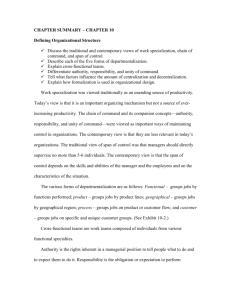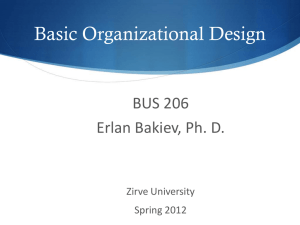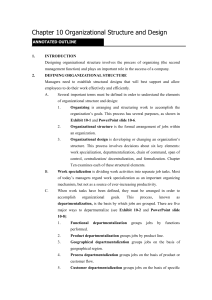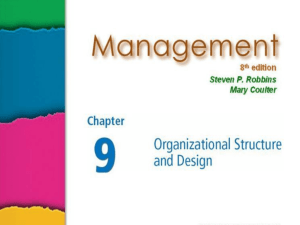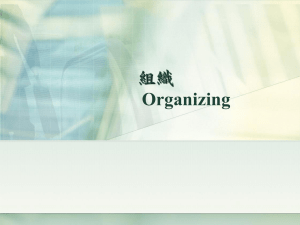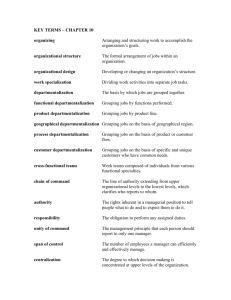Chapter 5 Basic Organization Designs
advertisement
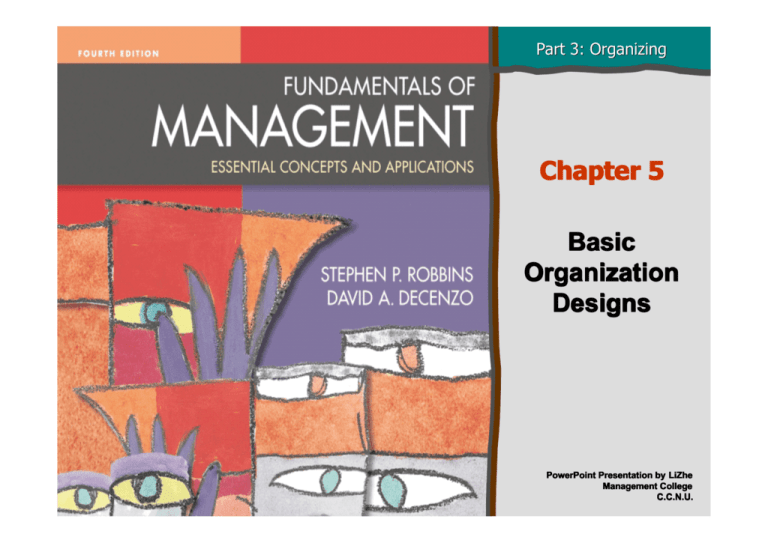
Part 3: Organizing Chapter 5 Basic Organization Designs PowerPoint Presentation by LiZhe Management College C.C.N.U. LEARNING OUTCOMES After reading this chapter, I will be able to: 1. Identify and define the six elements of organization structure. 2. Describe the advantages and disadvantages of work specialization. 3. Contrast authority and power. 4. Identify the five different ways by which management can departmentalize. 5. Contrast mechanistic and organic organizations. 6. Summarize the effect of strategy, size, technology, and environment on organization structures. 5–2 L E A R N I N G O U T C O M E S (cont’d) After reading this chapter, I will be able to: 7. Contrast the divisional and functional structures. 8. Explain the strengths of the matrix structure. 9. Describe the boundaryless organization and what elements have contributed to its development. 10. Explain what is meant by the term learning organization. 11. Describe what is meant by the term organization culture. 5–3 Organization Design and Structure • Organization design � A process in which managers develop or change their organization’s structure • Work specialization � A component of organization structure that involves having each discrete step of a job done by a different individual rather than having one individual do the whole job 5–4 Economies and Diseconomies of Work Specialization EXHIBIT 5.1 5–5 Organizational Structure: Control • Chain of command � The management principle that no person should report to more than one boss • Span of control � The number of subordinates a manager can direct efficiently and effectively 5–6 Organizational Structure: Control (cont (cont’’d) • Authority � The rights inherent in a managerial position to give orders and expect them to be obeyed • Power � An individual’s capacity to influence decisions • Responsibility � An obligation to perform assigned activities 5–7 Types of Organizational Authority • Line authority � The position authority (given and defined by the organization) that entitles a manager to direct the work of operative employees • Staff authority � Positions that have some authority (e.g., organization policy enforcement) but that are created to support, assist, and advise the holders of line authority 5–8 Chain of Command EXHIBIT 5.2 5–9 Line Versus Staff Authority EXHIBIT 5.3 5–10 Authority Versus Power EXHIBIT 5.4a 5–11 Authority Versus Power (cont (cont’’d) EXHIBIT 5.4b 5–12 Centralization And Decentralization • Centralization � A function of how much decision-making authority is pushed down to lower levels in an organization; the more centralized an organization, the higher the level at which decisions are made • Decentralization � The pushing down of decision-making authority to the lowest levels of an organization 5–13 Types of Power Coercive power Power based on fear. Reward power Power based on the ability to distribute something that others value. Legitimate power Power based on one one’’s position in the formal hierarchy. Expert power Power based on one one’’s expertise, special skill, or knowledge. Referent power Power based on identification with a person who has desirable resources or personal traits. EXHIBIT 5.5 5–14 Types of Departmentalization Functional Product Customer Geographic Process EXHIBIT 5 .6 5–15 Departmentalization • Functional departmentalization � The grouping of activities by functions performed • Product departmentalization � The grouping of activities by product produced • Customer departmentalization � The grouping of activities by common customers • Geographic departmentalization � The grouping of activities by territory • Process departmentalization � The grouping of activities by work or customer flow 5–16 Mechanistic and Organic Organizations • Mechanistic organization � The bureaucracy; a structure that is high in specialization, formalization, and centralization • Organic organization � An adhocracy; a structure that is low in specialization, formalization, and centralization Structure follows strategy 5–17 Mechanistic versus Organic Organizations • • • • Rigid hierarchical relationships Fixed duties Many rules Formalized communication channels • Centralized decision authority • Taller structures • Collaboration (both vertical and horizontal) • Adaptable duties • Few rules • Informal communication • Decentralized decision authority • Flatter structures EXHIBIT 5.7 5–18 Technology and Structure • Unit production � Production in terms of units or small batches • Mass production � Production in terms of large batch manufacturing • Process production � Production in terms of continuous processing 5–19 Organization Design Applications • Simple structure � An organization that is low in specialization and formalization but high in centralization • Functional structure � An organization in which similar and related occupational specialties are grouped together • Divisional structure � An organization made up of self-contained units 5–20 Functional Structure EXHIBIT 5.8 5–21 Divisional Structure EXHIBIT 5.9 5–22 Other Organizational Structures • Matrix structure � An organization in which specialists from functional departments are assigned to work on one or more projects led by a project manager • Team-based structure � An organization that consists entirely of work groups or teams • Boundaryless organization � An organization that is not defined or limited by boundaries or categories imposed by traditional structures 5–23 Sample Matrix Structure EXHIBIT 5.10 5–24 Learning Organization • An organization that has developed the capacity to continuously adapt and change because all members take an active role in identifying and resolving work-related issues. � Organization design � Information sharing � Leadership � Organizational culture 5–25 Characteristics of a Learning Organization Source: Based on P.M. Senge. The Fifth Discipline: The Art and Practice of Learning Organizations (New York: Doubleday, 1990); and R. M. Hodgetts, F. Luthans and S. M. Lee. “New Paradigm Organizations: From Total Quality to Learning to World Class, ” Organizational Dynamics (Winter 1994) pp. 4–19 EXHIBIT 5.11 5–26 Organization Culture • Organization culture � A system of shared meaning within an organization that determines, to a large degree, how employees act � Shared values are shown in cultural elements: � Stories, rituals, material symbols, and language unique to the organization � Results from the interaction between: � The founders’ biases and assumptions � What the first employees learn subsequently from their own experiences. 5–27 Ten Characteristics of Organization Culture • Member identity • Group emphasis • People focus • Unit integration • Control • Risk tolerance • Reward criteria • Conflict tolerance • Means-end orientation • Open-systems focus EXHIBIT 5.12 5–28
